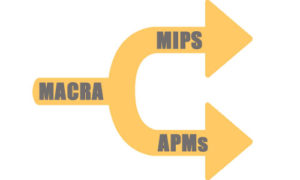
APMs are new ways for Medicare to pay health care providers for the care they give Medicare beneficiaries. Accountable Care Organizations or ACOs (groups of doctors, hospitals, and other health care providers, who come together voluntarily to give coordinated high quality care to their Medicare patients), Patient Centered Medical Homes, and bundled payment models (these models bundle payments for multiple services beneficiaries receive during an episode of care) are some examples of APMs.
APMs use quality measures comparable to measures under the MIPs, use certified electronic health record (EHR) technology, and has increasing percentage of payments linked to value. Legislation provides 5% bonus payments from 2019 to 2024 for physicians and physician organizations that join new models. To earn the 5% incentive payment in 2019 and 2020, at least 25% of Medicare revenues must be through an APM. In 2021 and 2022 at least 50% of Medicare revenues must be through an APM in order to receive the 5% incentive bonus.
While MIPS are seated in the ‘Fee for Service’ model, there are added stipulations for performance based bonuses and payments. Under MIPS, performance metrics include quality, resource use, and clinical practice improvement. MIPS work on a sliding scale. In 2019, the annual payment update will be 0.5 percent plus or minus 4 percent, based on a composite score on measures for four categories (clinical quality, meaningful use of health information technology, resource use and practice improvement). From 2020 through 2025, the baseline update will be 0 percent, with a 5 percent variance up or down based on performance in 2020, a 7 percent variance in 2021, and a 9 percent variance between 2022 and 2025. Then, starting in 2026, the baseline update will be 0.25 percent, with a variance of 9 percent.
MIPS will also pay a bonus for top performers. Those who score in the top 25th percentile of an annual performance threshold (as set by The Department of Health and Human) for MIPS participants between 2019 and 2024 will qualify for an additional annual performance adjustment of up to 10 percent. MACRA calls for up to $500 million annually to be put aside to pay top performers.
Whichever path your practice chooses, at the core of it is having an EHR to streamline your practice and improve your workflow. Microwize is been offering EHRs since 1997, and we are one of the largest value added healthcare IT firms in the USA – call today and speak to one of our sales representatives and learn more about how we can help your practice.

